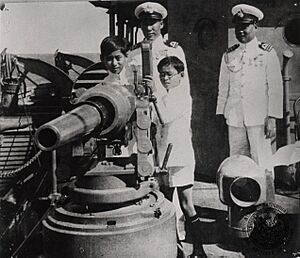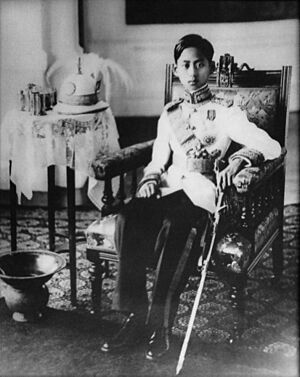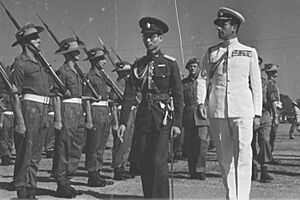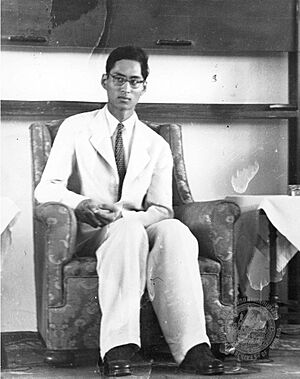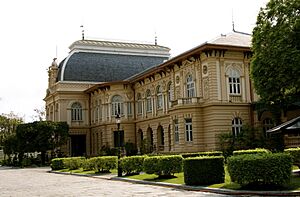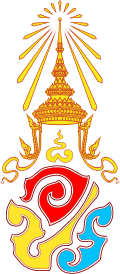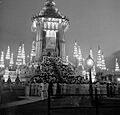Ananda Mahidol facts for kids
Quick facts for kids Ananda Mahidolอานันทมหิดล |
|||||||||
|---|---|---|---|---|---|---|---|---|---|
| King Rama VIII | |||||||||
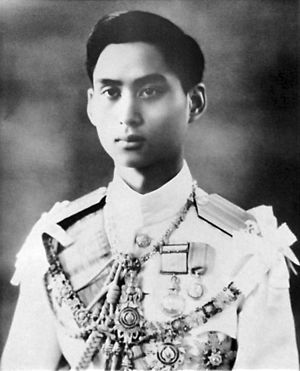
Formal portrait, 1946
|
|||||||||
| King of Thailand | |||||||||
| Reign | 2 March 1935 – 9 June 1946 | ||||||||
| Coronation | 11 August 1946 (posthumous) | ||||||||
| Predecessor | Prajadhipok (Rama VII) | ||||||||
| Successor | Bhumibol Adulyadej (Rama IX) | ||||||||
| Regent |
|
||||||||
| Prime ministers |
See list
|
||||||||
| Born | Prince Ananda Mahidol Mahidol 20 September 1925 Heidelberg, Germany |
||||||||
| Died | 9 June 1946 (aged 20) Boromphiman Residential Hall, Grand Palace, Bangkok, Thailand |
||||||||
| Burial | 29 March 1950 Royal Crematorium, Sanam Luang, Bangkok, Thailand |
||||||||
|
|||||||||
| House | Mahidol (Chakri dynasty) | ||||||||
| Father | Mahidol Adulyadej | ||||||||
| Mother | Sangwan Talapat | ||||||||
| Religion | Theravada | ||||||||
| Signature | |||||||||
| Ananda Mahidol | |
|---|---|
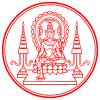
Privy Seal
|
|
| Thai name | |
| Thai | อานันทมหิดล |
| RTGS | Ananthamahidon |
Ananda Mahidol (born 20 September 1925 – died 9 June 1946) was the eighth king of Siam, which is now called Thailand. He belonged to the Chakri dynasty and was known as Rama VIII. When he became king in March 1935, he was only nine years old and living in Switzerland. He came back to Thailand in December 1945. Sadly, just six months later, in June 1946, he was found dead in his bed. At first, people thought it was an accident. However, investigations later suggested his death was not accidental. The events surrounding his death are still a mystery and have been discussed a lot.
Contents
What's in a Name?
Ananda Mahidol (Thai: อานันทมหิดล) is his birth name. It is one word in Thai. His uncle, King Vajiravudh, gave him this name on 13 October 1925. The name means "the joy of Mahidol". When he was a young prince, he used Mahidol as his family name, which was his father's name. So, his full name was Mom Chao Ananda Mahidol Mahidol.
When he became king, his title changed to Somdet Phra Chao Yu Hua Ananda Mahidol. This was the special title for a Thai king before his official crowning ceremony.
After he passed away, his brother, King Bhumibol Adulyadej, gave him a new, longer name to honor him. This new name was similar to those of other important kings like Mongkut and Chulalongkorn. Today, Thai people officially call him Phra Bat Somdet Phra Poramenthra Maha Ananda Mahidol Phra Atthama Ramathibodindara.
Early Life and Family
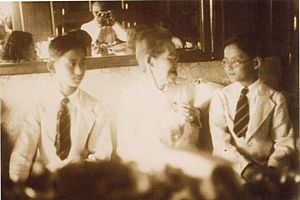
Prince Ananda Mahidol was born in Heidelberg, Germany. His father was Prince Mahidol Adulyadej of Songkla, who was a son of King Rama V. His mother was Mom Sangwan. At the time, his parents were studying in Germany. He was the first Thai King to be born outside of Thailand.
His family moved to Paris, then Lausanne, and later to Massachusetts. In 1927, his uncle, King Prajadhipok, gave him a higher royal rank. This also helped his older sister, Mom Chao Galyani Vadhana, and his younger brother, Bhumibol Adulyadej.
The family returned to Thailand in 1928. Sadly, his father, Prince Mahidol, passed away in 1929 when Ananda Mahidol was only four years old. His mother then raised the children by herself.
He went to Debsirin School in Bangkok for a short time. But in 1932, a big change happened in Thailand called the Siamese Revolution of 1932. This revolution ended the absolute power of the king. His grandmother, Queen Savang Vadhana, was worried about his safety because he was one of the possible heirs to the throne. So, his mother and children went back to Lausanne, Switzerland, in 1933. The official reason was for their health and education.
Prince Ananda Mahidol spent most of his childhood and youth in Switzerland. However, when King Prajadhipok was thinking about giving up the throne, the government asked his mother about Ananda Mahidol becoming the next king.
How He Became King
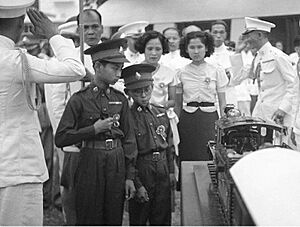
King Prajadhipok (Rama VII) decided to step down as king in 1935. This was due to disagreements with the new government and his own health issues. He chose not to name a successor.
According to the rules for who becomes king, Prince Ananda Mahidol was next in line. This was because his father, Prince Mahidol, was a son of Queen Savang Vadhana. She was the queen whose children were next in line after the previous king's mother.
Since Thailand now had a constitution, the government's cabinet had to decide. A very important person named Pridi Phanomyong convinced the cabinet that Prince Ananda Mahidol should be the next king. It was also easier for the government to have a king who was only nine years old and studying far away in Switzerland. So, on 2 March 1935, the National Assembly and the Thai government chose Prince Ananda Mahidol to become the eighth king of the Chakri dynasty.
His Time as King
Because the new king was still a child and studying in Switzerland, the National Assembly chose three people to act as his regents. These regents would rule the country until the king was old enough.
In 1938, when he was thirteen, Ananda Mahidol visited Siam for the first time as its king. His mother and younger brother, Bhumibol Adulyadej, came with him. Plaek Phibunsongkhram was the prime minister for most of King Ananda Mahidol's short reign.
World War II and Thailand
On 8 December 1941, Japan invaded Thailand. After some fighting, Thailand and Japan formed an alliance. This meant Thailand became part of the Axis powers during World War II. King Ananda was still in Switzerland finishing his studies, so Pridi Phanomyong acted as regent in his place.
Thailand officially joined the Axis powers in January 1942. However, the regent refused to sign the declaration of war against the Allied powers, making it legally invalid. Many Thai government members secretly helped the Allies. They were part of an underground group called the Seri Thai (Free Thai Movement). They shared secret information with British and American intelligence.
By 1944, it was clear that Japan was losing the war. Bangkok suffered a lot from Allied bombing raids. These attacks, along with economic problems, made the war and the government very unpopular. In July, the prime minister was removed from power by the Seri Thai group. Japan surrendered on 15 August 1945.
After the War
After World War II ended, King Ananda Mahidol could finally return to Thailand. He came back in December 1945, having finished his law degree. Even though he was young and didn't have much experience, he quickly became very popular with the Thai people. They were very happy to have their king back.
One memorable thing he did was visit Bangkok's Chinatown (Sampheng Lane). This visit helped to calm tensions between the Thai Chinese and Thai people after the war.
Some people from other countries thought that Ananda Mahidol didn't really want to be king and that his reign wouldn't last long. Louis Mountbatten, a British commander, met the king in January 1946. He described the king as a "frightened, short-sighted boy."
His Passing
On 9 June 1946, the king was found deceased in his bedroom at the Boromphiman Throne Hall. This was only four days before he was supposed to go back to Switzerland to finish his studies.
What Happened Next
When the news was first announced on 9 June, it was suggested that the king had accidentally died while handling his pistol.
Later, investigations were carried out to understand the events surrounding his death. The court concluded that King Ananda's death was not accidental.
King Ananda Mahidol was cremated at Sanam Luang, Bangkok, on 29 March 1950, four years after he passed away.
Images for kids
Tributes to King Ananda
-
Statue of King Ananda, erected by his brother, King Bhumibol, Wat Suthat, Bangkok, 1959
See also
 In Spanish: Ananda Mahidol para niños
In Spanish: Ananda Mahidol para niños
- History of Thailand (1932–1973)
- French-Thai War
- Japanese invasion of Thailand
- Free Thai Movement
- Rama VIII Bridge
- King Bhumibol Adulyadej
- List of unsolved deaths


